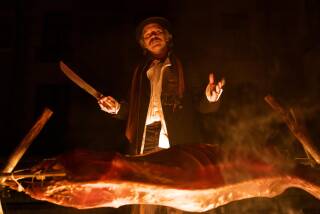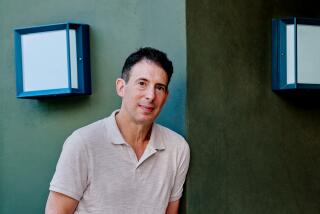A flu that felled millions
- Share via
Afraid of the flu? This flu season had people running scared and heading to their doctors for the vaccine after deaths made headlines around the nation. Now the public is fearfully watching the progress of avian flu across Southeast Asia. Don’t panic, please, though concern is justified: Lest we forget, the influenza pandemic of 1918-19, in terms of numbers of deaths, was the worst thing that ever happened to the human species.
That pandemic killed far more than half a million in the United States (the equivalent loss in our larger population today would be about 1.7 million). World mortality amounted to 50 million or possibly much more: We know very little about what happened in China. Similar losses in the world population today would be 175 million to 350 million.
Worse things have happened to specific populations -- the Black Death in 14th century Europe, for instance, or any one of several epidemics of yellow fever in 19th century New Orleans -- but nothing was as swift and deadly to our entire species as the flu that hit us at the end of World War I. It mowed down millions between the summer of 1918 and spring 1919 -- a mere 10 months.
“If the epidemic continues its mathematical rate of acceleration,” wrote Victor Vaughan, the head of the U.S. Army’s division of communicable diseases, in 1918, “civilization could easily disappear
But over time the pandemic slipped from society’s common memory. In recent decades, however, for some reason -- perhaps the decline of medical complacency associated with the AIDS crisis -- the great influenza outbreak has been making its way back into our minds. Several books have appeared by authors including Geoffrey Rice, Gina Kolata, David Getz and even me. None is superior to John M. Barry’s “The Great Influenza.” Barry puts the pandemic into a context of medical, national and world history, reminding us that our world treats illness much differently than our ancestors’ did.
Calling for a doctor was a mistake in 19th century America. You could become a doctor without knowing any chemistry, without ever having participated in an autopsy. Though medical training soon improved, in the 1920s a good many of our general practitioners were still inadequate. A lot of them doubted the germ theory and were still muttering about miasmas. Even good doctors didn’t know what to do about the flu. There were no magic bullet cures for viral infections -- and still aren’t -- and some reckless medicos tried typhoid vaccine, quinine, morphine, opium, even heroin. The best thing anyone could do for flu sufferers was to put them to bed and keep them there. Nurses were better at that than doctors, but legions of nurses, like doctors, had marched off to serve in the war.
What caused flu? Nobody knew at the time. Unfortunately, a great many here and abroad were sure that it was caused by a bacillus nicknamed after its discoverer, Richard Pfeiffer, one of the world’s most famous bacteriologists. Thousands and thousands of vaccine doses against Pfeiffer’s bacillus were whipped up and injected into peoples’ arms. These possibly may have been of some use against whatever microorganism had been chosen as the villain, but never against the flu virus.
But most experts at the time didn’t believe in viruses, which were so small that they could not be seen (not until the invention of the electron microscope in the 1930s). Again, the best thing to do was to go to bed and avoid your doctor. It’s possible he was carrying germs from a recently attended patient who might have been much worse off than you.
America was not prepared to fight a pandemic: Many cities were controlled by corrupt and dysfunctional political machines, and very few politicians of any variety knew much about epidemiology. The medical profession, Red Cross and some local governments did get organized, but usually after the peak of the pandemic in a given area. A few towns, such as Fairbanks, Alaska, got through the crisis by declaring quarantines and guarding their approaches, in some cases with armed men. So did Australia, which suffered far less than any other continent.
In the United States, the war effort hampered proper mobilization against the disease. Quarantines, school closures, factory shutdowns and cancellations of Liberty Bond marches might have slowed down the flu’s advance, but these were not implemented nor were public statements about the threat of disease -- all for fear of disrupting the war effort. Medical professionals, governors and mayors were urged to omit or soft-pedal statements pertaining to the pandemic. All in all, Americans reacted to the 1918 flu as did the Chinese to severe acute respiratory syndrome about a year ago.
President Wilson, fixated on events at the Western Front, didn’t delay the voyages of troopships to France, even though jamming thousands of soldiers into fetid quarters guaranteed the spread of disease and the deaths of hundreds. It is probable that the lives of many doughboys ordered to France and waiting at dockside were saved by Armistice Day, which came about halfway through the worst days of the pandemic.
Barry takes readers through the narrative of the great pandemic smoothly, but so have others. His special contribution in “The Great Influenza” is that he informs readers about the science of the subject, in 1918 as compared with 2004, intelligibly and without oversimplification.
What was distinctive about the 1918 flu? Not only did it kill more people than any other flu on record, Barry tells us, it also preferentially killed not, as flu usually does, the very young or very old but people in their 20s and 30s, in the prime of life. No one really knows why, but the massive overreaction of the immune systems of healthy young adults to a new virus may have had something to do with it.
The 1918 virus hit most people as flu viruses do today (with sniffles, cough and aches) and, 10 or so days later, they recovered and were back on their feet. But a lot of them were so weakened by the flu that they succumbed to bacterial pneumonia several weeks after their first respiratory symptoms and pains. A considerable minority reacted to the infection as if hit by a truck and died in a day or less. They often turned blue or even black because the infection cut off their oxygen. At autopsy their lungs often looked as if they had been scorched. The pandemic gradually faded as people’s immune systems adjusted and as the virus mutated into a lesser form.
Barry’s well-researched, well-written account raises the obvious question: Could it happen again? And the answer is: Of course it could. The relevant rule of thumb is that we have at least one influenza pandemic every generation. In fact, despite SARS, we haven’t had a real earthshaker since 1968 and are due. When it comes, will it be as bad as in 1918? Probably not: Now we have antibiotics to fight secondary bacterial infection, provided we have enough on hand and time enough to match their distribution to the pandemic’s lightning spread. They wouldn’t, of course, halt viral infection.
We also have a worldwide network of pandemic warning stations to provide us with, we hope, the time needed to prepare and administer vaccines against new varieties of the flu virus. But no place on Earth is more than two days’ airline travel from any other place. And now we have thousands of public health experts who know a lot about how flu viruses evolve. Some of them are presiding over the slaughter of millions of chickens in Southeast Asia right now to stop the spread of avian flu there.
There was a bit of doggerel that everyone, President Wilson and all, chanted in 1918:
I had a little bird
And its name was Enza.
I opened the window
And influenza.
One only hopes that the window can be closed much faster today.






